News
Drought hits hydro-powered Kariba Dam
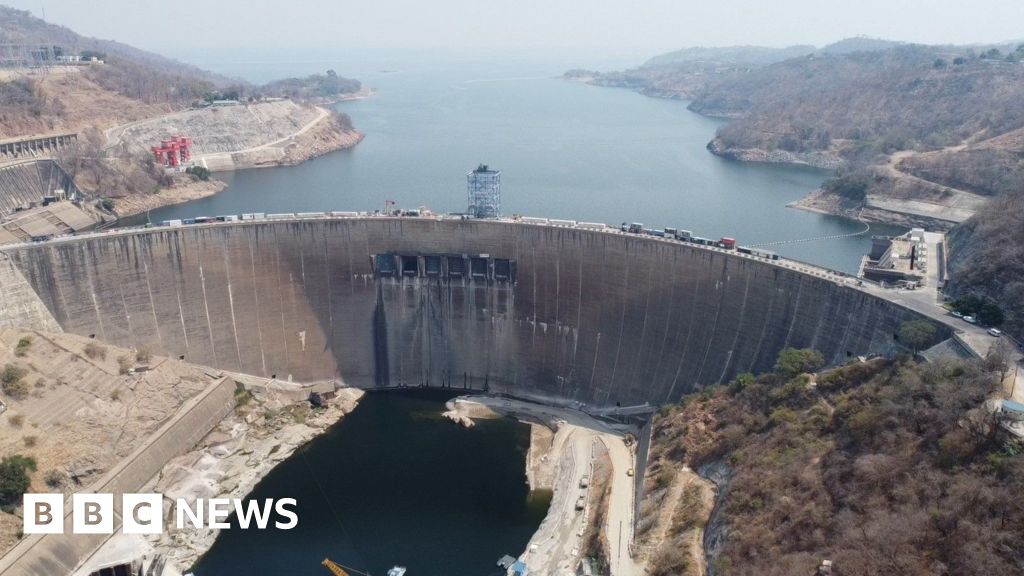
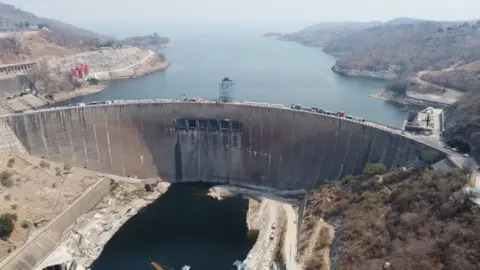 BBC / Kennedy Gondwe
BBC / Kennedy GondweDespite having the mighty Zambezi River and the massive hydro-powered Kariba Dam, Zambia is currently grappling with the worst electricity blackouts in living memory.
The crisis is so severe that cities and towns across the country are sometimes without electricity for three consecutive days, with people counting themselves lucky if the lights come on for an hour or two.
The power cuts have come as a shock to the 43% of Zambians who are connected to the grid and have taken electricity for granted all their lives.
But one of the severest droughts in decades – caused by the El Niño weather phenomenon – has decimated Zambia’s power-generation capacity.
Nowadays, I sometimes go to bars and restaurants to find people not eating or drinking – they are there just to charge their phones amid the pounding noise of generators.
There is also a booming business of people making money by charging the phones of those without power.
Zambia sources up to 84% of its electricity from water reservoirs such as lakes and rivers, while only 13% comes from coal.
Contributions from solar, diesel and heavy fuel oil are even lower, accounting for 3%.
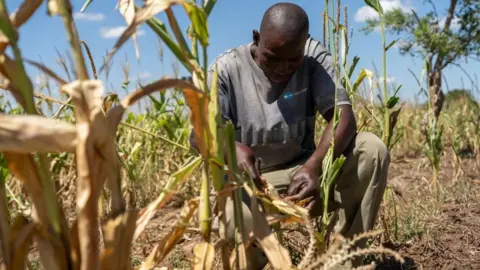 EPA
EPAFor several weeks, the crisis was compounded while the country’s only coal-fired power plant, Maamba Energy, was not operating at maximum capacity as it underwent routine maintenance work.
On Wednesday, there was finally some good news when Minister of Energy Makozo Chikote said the plant was now fully operational, and Zambians would have at least three hours of electricity a day.
President Hakainde Hichilema declared the drought a national disaster in February but the government has been unable to solve the energy crisis because Zambia is heavily reliant on the Kariba Dam for its electricity.
A financial crunch also severely restricted the government’s ability to import power as suppliers wanted payment upfront, though a spokesman for state-owned power utility Zesco, Matongo Maumbi, told the BBC’s Focus on Africa podcast that electricity was being imported from Mozambique and South Africa to ease the crisis, especially in the mining industry – Zambia’s main export earner and source of foreign currency.
Located on the Zambezi, the fourth-longest river in Africa, Kariba was built in the 1950s and is the reservoir for the country’s largest underground power station, Kariba North Bank Power Station. A power station on the other bank serves Zimbabwe.
But because of the drought that has led to parts of the river drying up, only one of the six turbines at Zambia’s power station is operating, resulting in the generation of a paltry 7% of the 1,080 MW installed at Kariba.
The dam retains the water of the Zambezi with a curving wall that is 128m (420ft) high, 579m (1,900ft) long and 21m (69ft) thick.
Engineer Cephas Museba – who has been working for the state-owned power utility Zesco for 19 years – says he has never seen water levels so low at Kariba.
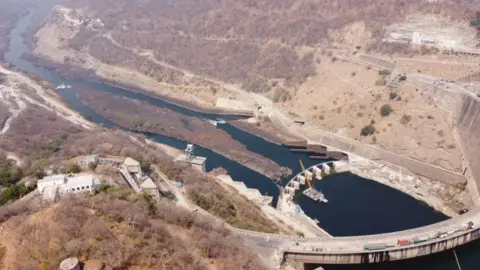 BBC / Kennedy Gondwe
BBC / Kennedy Gondwe“I think we stopped receiving the rains as early as February. It’s supposed to rain up to April. If we compare the history of this basin, this is the lowest we have received,” he told me.
It has triggered an electricity crisis that is being felt in every business and home.
Some companies are opening for fewer hours, and retrenching staff.
It can even be difficult to find bread – bakeries are making fewer loaves because they find it too expensive to keep generators running.
Fortunately, the government has installed huge generators in some markets, government offices and hospitals, though stories are still being shared on social media of how kidney patients are struggling to cope.
Some patients need to be hooked up to a dialysis machine for up to three hours a day but power only gets restored for about an hour or two, sometimes after midnight.
On other occasions, there is no electricity at all for 72 hours in a row.
On those days, I wear the same clothes as the previous day, rather than a washed but wrinkled shirt that has not been ironed.
Life has become more difficult for everyone.
One day recently, I woke up to be greeted by a foul smell as blood flowed from under the fridge.
All the meat we had bought had gone off and we had to give it to our German Shepherd dog, the happiest member of our household these days.
 BBC / Kennedy Gondwe
BBC / Kennedy GondweThe other day I bought relish from a supermarket – but when I opened the package at the dinner table I realised that it was more food for our dog.
My food budget, already tight because of the cost-of-living crisis, is now even tighter. Buying perishable items in bulk at a cheaper price is completely out of the question as they will just rot.
The government has been encouraging homes and businesses to switch to solar, and has scrapped import taxes for solar equipment to make it cheaper to buy.
But some people say their solar panels do not generate enough electricity when there is little sunlight – and they cannot afford to install more panels. Most Zambians cannot afford solar panels at all.
Now, many families have resorted to cooking and heating water on portable gas stoves – but shops have been running out of gas too because of high demand.
So in desperation and because it is cheaper, they buy charcoal to cook and heat water – despite its negative impact on the environment and the climate.
The electricity crisis has also had an impact on the boreholes that middle-class families have dug on their properties.
As boreholes work with electricity and solar-powered pumps, homes are now also without a constant supply of water, making it impossible to even flush the toilet.
In some schools, children are advised to take five litres of water each day to reduce the possibility of a sanitation crisis – and the outbreak of waterborne diseases like cholera, which hit the country at the start of the year.
Many families now fill buckets – or bath tubs – with water, hoping it will last until the lights are back, and toilets can be flushed.
All of this has left Zambians frustrated and angry. They point out that the blackouts highlight the failure of successive governments to plan ahead – something that President Hichilema’s administration has now pledged to do.
Mr Maumbi said that Zesco was investing in more energy sources, including solar plants, so that dependency on hydro-power falls to around 60%.
But Zambia’s focus is not only on green energy – coal is also in the mix.
In July, the energy regulator approved plans to build only the country’s second coal-fired power plant.
It is the dirtiest fossil fuel, producing the most greenhouse gases when burnt, but the government feels that to avoid a similar crisis in the future, it has little option but to press ahead.
You may also be interested in:
 Getty Images/BBC
Getty Images/BBCNews
Customers face heating problems if meters not replaced
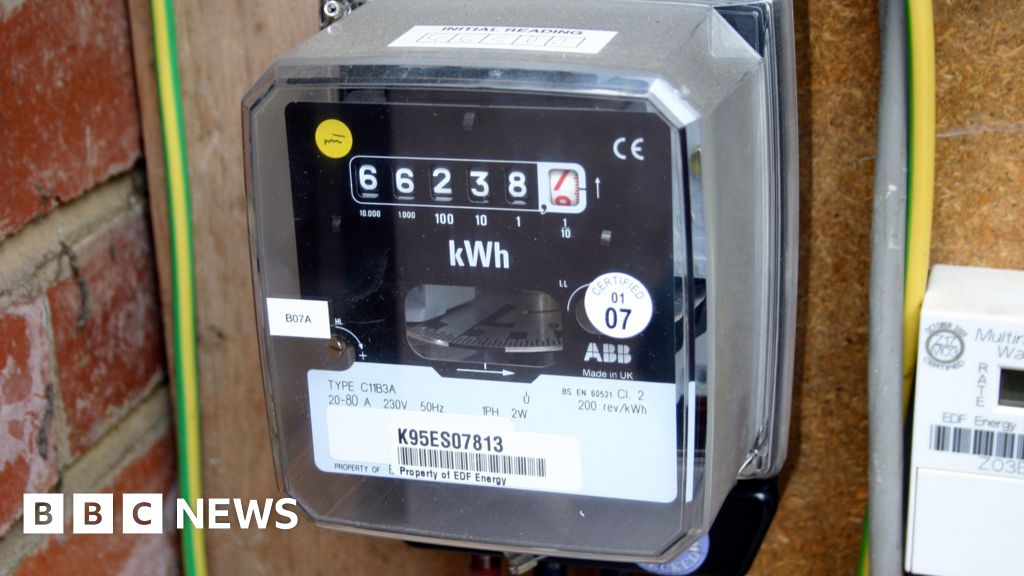
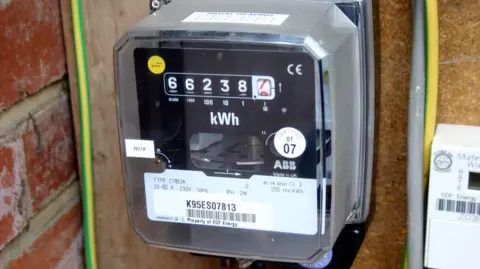 BBC
BBCAround 175,000 Scottish energy customers face major problems with their home heating systems if they do not have their meters upgraded in the coming months.
The Radio Teleswitching Service (RTS) controls energy tariffs for hundreds of thousands of homes, sending signals to store energy via the BBC’s longwave transmitter.
The signal is due to be turned off for good next June but hundreds of thousands of homes have still to be converted to updated systems.
If this does not happen, customers could lose control of heating and hot water, leaving the systems either permanently on or off.
The deadline has already been extended from last March, but energy regulator Ofgem said that work to replace the old infrastructure needed to be accelerated.
Charlotte Friel is its director of consumer protection.
“The pace of replacement is not where it needs to be,” she told BBC Radio’s Good Morning Scotland programme.
“The industry has been working on RTS replacement for some time and has replaced 200,000 meters this year, but there are still 700,000 to go.
“This call to action is about bringing the industry together and emphasising the pace needed to accelerate the replacement programme, dedicating resources, getting boots on the ground in the right places.”
How do you know you have an RTS meter?
Some customers may be unaware their meters are controlled by RTS. But there are clues.
Ms Friel said: “Typically if your meter switches between on and off-peak rates, if your home is heated by electric storage heaters and if you live in a region that is off-gas supply, these are typical features that could mean you have an RTS meter.”
The RTS switches the meter from on to off-peak mode. Once that signal is switched off it will mean the customer loses control of their heating and hot water.
This could have different outcomes in different households.
In worst case scenarios, it could mean that the heating and hot water is permanently on or permanently off.
Ms Friel said: “Some of the challenge is around getting customers to engage with their suppliers. Not everyone understands the arrangements they are on and we appreciate that.
“It is on suppliers to reach out to customers but they can play their part too by letting engineers in to upgrade their meters.”
She said that the vast majority of cases are straightforward replacements. There will be some more complex installations but Ofgem is confident there is a technical solution for everybody with an RTS meter.
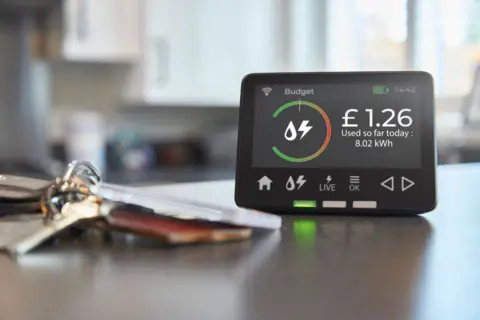 Getty Images
Getty ImagesFrazer Scott, from campaigning group Energy Action Scotland, said there were growing concerns around the switch happening on time.
“With the scale of these changes over such a short period of time, we’re really concerned that it’s simply not going to happen,” he said.
“And the consequences are considerable for all those households that might be affected when it’s switched off.”
He added: “It is unacceptable that it is so late in the day with so little certainty.”
Mr Scott said it now felt as though the industry was working together to solve the issue but described it as the “eleventh hour”.
“It is incredibly worrying but at least they’ve finally got together some kind of taskforce and hopefully this will mean there will be an acceleration in this change,” he said.
He said about a quarter of the affected households were in Scotland and the country was “disproportionately affected”.
Mr Scott also called for “proper support” for people in case their heating fails.
“People just want a certainty of supply with a much cheaper cost,” he added.
“What we’re looking for from industry is certainty that people’s bills will not rise as a result of making a meter change, which would seem ridiculous.
“But at the moment we’ve not even got those kinds of assurances from industry, and nor is it clear who will pay for additional costs should a household require them to ensure they have a safe supply to their house.”
CryptoCurrency
Tesla stock drops 3% after Q3 deliveries fall short of estimates
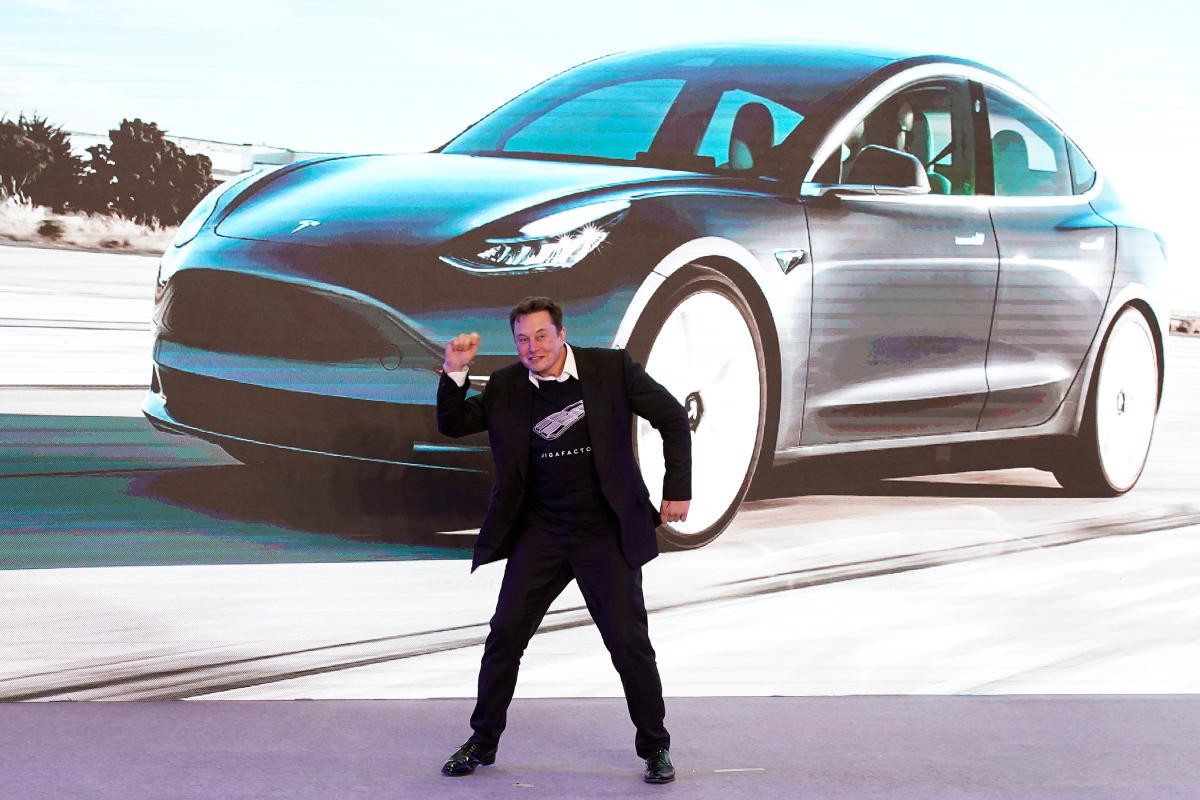
Tesla (TSLA) announced third quarter deliveries on Wednesday that slightly missed expectations, sending the stock down about 3%.
The EV maker delivered 462,890 vehicles in the three months ending Sept. 30, up 6.4% quarter over quarter to mark the first quarter of delivery growth this year. The numbers also came in ahead of the 435,059 EVs the company delivered in the year-ago period.
Wall Street had expected Tesla to deliver closer to 463,897, according to Bloomberg.
The Model 3 and Model Y represented the bulk of Tesla’s overall total, with those two vehicles combining for 439,975 deliveries.
Prior to the delivery numbers’ release, Tesla stock had been up around 20% in the past month, fueled by optimism about its upcoming robotaxi event on Oct. 10 and good news coming out of China indicating rising sales there.
But investors have also debated a “notably lower” annual vehicle growth rate, which Tesla warned about after the first quarter.
The company is currently dealing with stiff competition in China from Chinese automakers like BYD and Xpeng. Recent price cuts have also squeezed profit margins as competition intensifies.
Analysts have said next week’s robotaxi event will serve as a pivotal moment for the company’s future and its plans to further utilize artificial intelligence.
“We believe Robotaxi Day will be seminal and historical day for Musk and Tesla and marks a new chapter of growth around autonomous, FSD, and AI future at Tesla,” Wedbush analyst Dan Ives wrote in a note to clients on Tuesday.
Tesla will report third quarter earnings on Oct. 23.
Alexandra is a Senior Reporter at Yahoo Finance. Follow her on X @alliecanal8193 and email her at alexandra.canal@yahoofinance.com
Pras Subramanian is a reporter for Yahoo Finance. You can follow him on Twitter and on Instagram.
Click here for the latest stock market news and in-depth analysis, including events that move stocks
Read the latest financial and business news from Yahoo Finance
CryptoCurrency
FTX bankruptcy estate auctioning Worldcoin tokens this week


According to CoinGecko, Worldcoin currently has a market capitalization of approximately $792 million and a 494 million circulating supply.
CryptoCurrency
SEC files appeal in Ripple lawsuit


The Securities and Exchange Commission first filed the lawsuit against Ripple Labs and both its founders in December 2020.
CryptoCurrency
Fantom price gains 70% in 30 days — What’s driving FTM?


Fantom price defies the crypto market downtrend as traders anticipate a new token launch and mainnet upgrade.
CryptoCurrency
Crypto lawyers on Telegram CEO Pavel Durov’s ‘crimes’ — Is it legal?


Was it right to arrest Telegram founder Pavel Durov? Or is it like arresting a telco CEO because criminals discussed crime on a phone call?
-

 Womens Workouts1 week ago
Womens Workouts1 week ago3 Day Full Body Women’s Dumbbell Only Workout
-

 Technology2 weeks ago
Technology2 weeks agoWould-be reality TV contestants ‘not looking real’
-

 Science & Environment2 weeks ago
Science & Environment2 weeks agoHow to unsnarl a tangle of threads, according to physics
-

 Science & Environment2 weeks ago
Science & Environment2 weeks agoMaxwell’s demon charges quantum batteries inside of a quantum computer
-

 Science & Environment2 weeks ago
Science & Environment2 weeks agoHyperelastic gel is one of the stretchiest materials known to science
-

 Science & Environment2 weeks ago
Science & Environment2 weeks ago‘Running of the bulls’ festival crowds move like charged particles
-

 News2 weeks ago
News2 weeks agoOur millionaire neighbour blocks us from using public footpath & screams at us in street.. it’s like living in a WARZONE – WordupNews
-

 Science & Environment2 weeks ago
Science & Environment2 weeks agoHow to wrap your mind around the real multiverse
-

 Science & Environment2 weeks ago
Science & Environment2 weeks agoLiquid crystals could improve quantum communication devices
-

 Science & Environment2 weeks ago
Science & Environment2 weeks agoSunlight-trapping device can generate temperatures over 1000°C
-

 Science & Environment2 weeks ago
Science & Environment2 weeks agoITER: Is the world’s biggest fusion experiment dead after new delay to 2035?
-

 Science & Environment2 weeks ago
Science & Environment2 weeks agoPhysicists are grappling with their own reproducibility crisis
-

 Science & Environment2 weeks ago
Science & Environment2 weeks agoQuantum ‘supersolid’ matter stirred using magnets
-

 News2 weeks ago
News2 weeks agoYou’re a Hypocrite, And So Am I
-

 Science & Environment2 weeks ago
Science & Environment2 weeks agoWhy this is a golden age for life to thrive across the universe
-

 Science & Environment2 weeks ago
Science & Environment2 weeks agoQuantum forces used to automatically assemble tiny device
-

 Sport2 weeks ago
Sport2 weeks agoJoshua vs Dubois: Chris Eubank Jr says ‘AJ’ could beat Tyson Fury and any other heavyweight in the world
-

 Science & Environment2 weeks ago
Science & Environment2 weeks agoCaroline Ellison aims to duck prison sentence for role in FTX collapse
-

 Science & Environment2 weeks ago
Science & Environment2 weeks agoNuclear fusion experiment overcomes two key operating hurdles
-

 Science & Environment2 weeks ago
Science & Environment2 weeks agoNerve fibres in the brain could generate quantum entanglement
-

 Science & Environment2 weeks ago
Science & Environment2 weeks agoTime travel sci-fi novel is a rip-roaringly good thought experiment
-

 Science & Environment2 weeks ago
Science & Environment2 weeks agoLaser helps turn an electron into a coil of mass and charge
-
News2 weeks ago
the pick of new debut fiction
-

 News2 weeks ago
News2 weeks agoIsrael strikes Lebanese targets as Hizbollah chief warns of ‘red lines’ crossed
-

 CryptoCurrency2 weeks ago
CryptoCurrency2 weeks agoCardano founder to meet Argentina president Javier Milei
-

 Science & Environment2 weeks ago
Science & Environment2 weeks agoMeet the world's first female male model | 7.30
-

 Womens Workouts2 weeks ago
Womens Workouts2 weeks agoBest Exercises if You Want to Build a Great Physique
-

 News2 weeks ago
News2 weeks agoWhy Is Everyone Excited About These Smart Insoles?
-
Business2 weeks ago
JPMorgan in talks to take over Apple credit card from Goldman Sachs
-

 Science & Environment2 weeks ago
Science & Environment2 weeks agoA slight curve helps rocks make the biggest splash
-

 News2 weeks ago
News2 weeks ago▶️ Media Bias: How They Spin Attack on Hezbollah and Ignore the Reality
-

 Science & Environment2 weeks ago
Science & Environment2 weeks agoQuantum time travel: The experiment to ‘send a particle into the past’
-

 Science & Environment2 weeks ago
Science & Environment2 weeks agoWhy we need to invoke philosophy to judge bizarre concepts in science
-

 CryptoCurrency2 weeks ago
CryptoCurrency2 weeks agoBitcoin miners steamrolled after electricity thefts, exchange ‘closure’ scam: Asia Express
-

 CryptoCurrency2 weeks ago
CryptoCurrency2 weeks agoDorsey’s ‘marketplace of algorithms’ could fix social media… so why hasn’t it?
-

 CryptoCurrency2 weeks ago
CryptoCurrency2 weeks agoDZ Bank partners with Boerse Stuttgart for crypto trading
-

 CryptoCurrency2 weeks ago
CryptoCurrency2 weeks agoBitcoin bulls target $64K BTC price hurdle as US stocks eye new record
-

 CryptoCurrency2 weeks ago
CryptoCurrency2 weeks agoLow users, sex predators kill Korean metaverses, 3AC sues Terra: Asia Express
-

 CryptoCurrency2 weeks ago
CryptoCurrency2 weeks agoEthereum is a 'contrarian bet' into 2025, says Bitwise exec
-

 Womens Workouts2 weeks ago
Womens Workouts2 weeks agoEverything a Beginner Needs to Know About Squatting
-

 News2 weeks ago
News2 weeks agoFour dead & 18 injured in horror mass shooting with victims ‘caught in crossfire’ as cops hunt multiple gunmen
-

 Womens Workouts1 week ago
Womens Workouts1 week ago3 Day Full Body Toning Workout for Women
-

 Travel1 week ago
Travel1 week agoDelta signs codeshare agreement with SAS
-

 Politics1 week ago
Politics1 week agoHope, finally? Keir Starmer’s first conference in power – podcast | News
-

 Health & fitness2 weeks ago
Health & fitness2 weeks agoThe maps that could hold the secret to curing cancer
-

 Science & Environment2 weeks ago
Science & Environment2 weeks agoFuture of fusion: How the UK’s JET reactor paved the way for ITER
-

 CryptoCurrency2 weeks ago
CryptoCurrency2 weeks agoRedStone integrates first oracle price feeds on TON blockchain
-

 Sport2 weeks ago
Sport2 weeks agoUFC Edmonton fight card revealed, including Brandon Moreno vs. Amir Albazi headliner
-

 CryptoCurrency2 weeks ago
CryptoCurrency2 weeks agoBlockdaemon mulls 2026 IPO: Report
-

 Technology2 weeks ago
Technology2 weeks agoiPhone 15 Pro Max Camera Review: Depth and Reach
-

 News2 weeks ago
News2 weeks agoBrian Tyree Henry on voicing young Megatron, his love for villain roles
-

 CryptoCurrency2 weeks ago
CryptoCurrency2 weeks agoCoinbase’s cbBTC surges to third-largest wrapped BTC token in just one week
-

 Health & fitness2 weeks ago
Health & fitness2 weeks agoThe secret to a six pack – and how to keep your washboard abs in 2022
-

 Science & Environment2 weeks ago
Science & Environment2 weeks agoBeing in two places at once could make a quantum battery charge faster
-

 Science & Environment2 weeks ago
Science & Environment2 weeks agoA new kind of experiment at the Large Hadron Collider could unravel quantum reality
-

 Science & Environment2 weeks ago
Science & Environment2 weeks agoHow one theory ties together everything we know about the universe
-

 Science & Environment2 weeks ago
Science & Environment2 weeks agoUK spurns European invitation to join ITER nuclear fusion project
-

 Science & Environment2 weeks ago
Science & Environment2 weeks agoHow do you recycle a nuclear fusion reactor? We’re about to find out
-

 Science & Environment2 weeks ago
Science & Environment2 weeks agoTiny magnet could help measure gravity on the quantum scale
-

 CryptoCurrency2 weeks ago
CryptoCurrency2 weeks agoCrypto scammers orchestrate massive hack on X but barely made $8K
-

 CryptoCurrency2 weeks ago
CryptoCurrency2 weeks agoTelegram bot Banana Gun’s users drained of over $1.9M
-

 CryptoCurrency2 weeks ago
CryptoCurrency2 weeks agoVonMises bought 60 CryptoPunks in a month before the price spiked: NFT Collector
-

 CryptoCurrency2 weeks ago
CryptoCurrency2 weeks ago‘No matter how bad it gets, there’s a lot going on with NFTs’: 24 Hours of Art, NFT Creator
-

 CryptoCurrency2 weeks ago
CryptoCurrency2 weeks agoSEC asks court for four months to produce documents for Coinbase
-
Business2 weeks ago
How Labour donor’s largesse tarnished government’s squeaky clean image
-

 News2 weeks ago
News2 weeks agoBrian Tyree Henry on voicing young Megatron, his love for villain roles
-

 Womens Workouts2 weeks ago
Womens Workouts2 weeks agoHow Heat Affects Your Body During Exercise
-

 Womens Workouts2 weeks ago
Womens Workouts2 weeks agoKeep Your Goals on Track This Season
-

 Science & Environment2 weeks ago
Science & Environment2 weeks agoCNN TÜRK – 🔴 Canlı Yayın ᴴᴰ – Canlı TV izle
-

 Technology1 week ago
Technology1 week agoRobo-tuna reveals how foldable fins help the speedy fish manoeuvre
-

 Servers computers1 week ago
Servers computers1 week agoWhat are the benefits of Blade servers compared to rack servers?
-

 Science & Environment1 week ago
Science & Environment1 week agoX-rays reveal half-billion-year-old insect ancestor
-

 Technology5 days ago
Technology5 days ago‘From a toaster to a server’: UK startup promises 5x ‘speed up without changing a line of code’ as it plans to take on Nvidia, AMD in the generative AI battlefield
-

 News2 weeks ago
News2 weeks agoChurch same-sex split affecting bishop appointments
-

 Technology2 weeks ago
Technology2 weeks agoFivetran targets data security by adding Hybrid Deployment
-

 CryptoCurrency2 weeks ago
CryptoCurrency2 weeks agoLouisiana takes first crypto payment over Bitcoin Lightning
-

 CryptoCurrency2 weeks ago
CryptoCurrency2 weeks ago$12.1M fraud suspect with ‘new face’ arrested, crypto scam boiler rooms busted: Asia Express
-

 CryptoCurrency2 weeks ago
CryptoCurrency2 weeks agoDecentraland X account hacked, phishing scam targets MANA airdrop
-

 CryptoCurrency2 weeks ago
CryptoCurrency2 weeks agoBitcoin price hits $62.6K as Fed 'crisis' move sparks US stocks warning
-

 CryptoCurrency2 weeks ago
CryptoCurrency2 weeks agoCertiK Ventures discloses $45M investment plan to boost Web3
-

 CryptoCurrency2 weeks ago
CryptoCurrency2 weeks agoBeat crypto airdrop bots, Illuvium’s new features coming, PGA Tour Rise: Web3 Gamer
-

 CryptoCurrency2 weeks ago
CryptoCurrency2 weeks ago‘Silly’ to shade Ethereum, the ‘Microsoft of blockchains’ — Bitwise exec
-

 CryptoCurrency2 weeks ago
CryptoCurrency2 weeks agoVitalik tells Ethereum L2s ‘Stage 1 or GTFO’ — Who makes the cut?
-

 CryptoCurrency2 weeks ago
CryptoCurrency2 weeks agoEthereum falls to new 42-month low vs. Bitcoin — Bottom or more pain ahead?
-
Business2 weeks ago
Thames Water seeks extension on debt terms to avoid renationalisation
-
Politics2 weeks ago
‘Appalling’ rows over Sue Gray must stop, senior ministers say | Sue Gray
-

 Politics2 weeks ago
Politics2 weeks agoLabour MP urges UK government to nationalise Grangemouth refinery
-

 News2 weeks ago
News2 weeks agoBrian Tyree Henry on his love for playing villains ahead of “Transformers One” release
-
Politics2 weeks ago
UK consumer confidence falls sharply amid fears of ‘painful’ budget | Economics
-

 Womens Workouts2 weeks ago
Womens Workouts2 weeks agoWhich Squat Load Position is Right For You?
-

 TV2 weeks ago
TV2 weeks agoCNN TÜRK – 🔴 Canlı Yayın ᴴᴰ – Canlı TV izle
-

 News7 days ago
News7 days agoUS Newspapers Diluting Democratic Discourse with Political Bias
-

 Politics2 weeks ago
Politics2 weeks agoTrump says he will meet with Indian Prime Minister Narendra Modi next week
-

 Technology2 weeks ago
Technology2 weeks agoIs carbon capture an efficient way to tackle CO2?
-

 Technology2 weeks ago
Technology2 weeks agoCan technology fix the ‘broken’ concert ticketing system?
-

 Science & Environment2 weeks ago
Science & Environment2 weeks agoSingle atoms captured morphing into quantum waves in startling image
-

 Science & Environment2 weeks ago
Science & Environment2 weeks agoHow Peter Higgs revealed the forces that hold the universe together
-

 Science & Environment2 weeks ago
Science & Environment2 weeks agoA tale of two mysteries: ghostly neutrinos and the proton decay puzzle
-

 CryptoCurrency2 weeks ago
CryptoCurrency2 weeks ago2 auditors miss $27M Penpie flaw, Pythia’s ‘claim rewards’ bug: Crypto-Sec
-

 CryptoCurrency2 weeks ago
CryptoCurrency2 weeks agoJourneys: Robby Yung on Animoca’s Web3 investments, TON and the Mocaverse


You must be logged in to post a comment Login